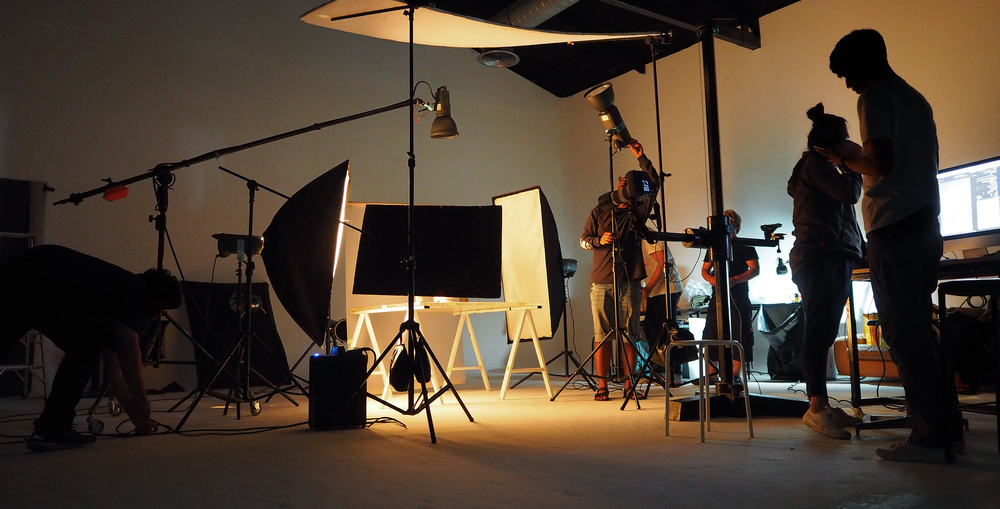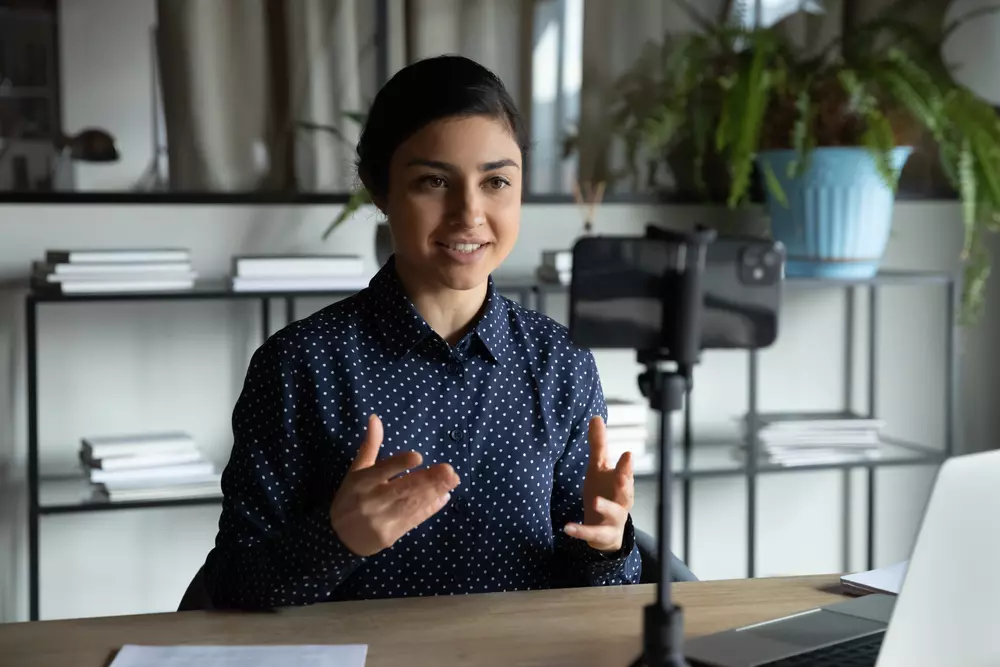
How to Create Lighting for Videos and Make Your Content Look Professional
Video lighting skills are essential for digital influencers and content creators. Poorly captured images in poor light make them and their product look unprofessional, in addition to making it difficult to understand the content.

What will we see in this post
Before recording a video, the director traditionally shouts “lights, camera, action!” This is the cue for the crew to begin recording. This choice of words is not random. Without good video lighting, there’s no usable image.
Lighting directs the viewer’s gaze, highlighting objects and creating the context you need for your recording. Therefore, good lighting is as important for your video as the script and the audio.
The same rule also applies to people who work as digital influencers or content creators. Poorly captured images in poor light make them and their product look unprofessional, in addition to making it difficult to understand the content.
The good news is that you can create video lighting by using inexpensive equipment or even household items. Here are a few tips!
Why you should worry about your video lighting
Although the recording environment can be well-lit, cameras cannot always capture enough light on their own, which can create blurry images with a grainy appearance.
This loss of quality happens on any type of equipment, regardless if you are recording with a smartphone or a DSLR camera.
It’s possible to correct a few details in editing, but depending on the environment’s lighting while recording, not even the most experienced editor can save your content.
To avoid this, it’s important to think about your video’s lighting from the start. Where will you be recording? What is the background like? What type of image do you wish to convey to those watching?
Professional lighting requires an investment in equipment and a few years of practice, but there are a few techniques that you can use to make sure that people can clearly see what you are recording.
For example, use more than one light point and create contrast between the actor and the background.
VIDEO: How to make more professional-looking videos with your home studio
Types of light you will need
Video lighting isn’t rocket science, but you will need a minimal structure to start. Below we have listed the most common equipment for simple videos where the camera will stand still.
Soft box
A soft box is widely used because it creates soft and diffused light that, when correctly directed, reduces shadows and enhances the natural features of the person in front of the camera.
The equipment consists of a fluorescent lamp attached to a box, lined with a bright surface, and can be made with items you have at home, such as a shoebox. Check out a few homemade softbox tutorials.
Sun Gun
A sun gun is the best choice for a fill light because it provides a more yellowish light. We’ll talk about fill light later in this text if you’re not familiar with the concept.
This equipment is rectangular, consisting of small LED panels, and has no outlet, which makes it ideal for both inside and outside scenes.
Backlight
Backlights are necessary for those who wish to record videos in a studio because they provide contrast between the actor and the background, giving a sense of depth.
Extra tip:
Choose bulbs between 5,000 and 5,500 kelvin, which generate whiter light that facilitates the editing process.
Kelvin is a unit that measures the temperature of the bulb’s color. Values above or below those recommended may add a bluish or reddish effect to your images.
When you should use natural light
For outdoor scenes, the best choice is to use as much daylight as you can; therefore, pay attention to the time you start recording so that the lighting doesn’t change much from one scene to the next.
Never record with your back to the windows because your camera lens might compensate for the excess light. This will result in making the recorded object have only a visible silhouette. Stand in front of the window in favor of the light.
Environments lit artificially are easier to control and more predictable. Maintain control over intensity, color, shading, and the actual direction of the light source when using artificial lighting setups.
If you are recording at home, choose to position the camera in front of walls with solid colors (without wallpaper and preferably with darker shades).
Remember to preserve the visual identity of your videos and do not choose a scenario that is the complete opposite of your intended vision.
Avoid mixing indoor and outdoor lighting. Your camera is programmed to “see” color temperature, and the mixture of sunlight with artificial lighting can create an amateurish effect in your video.
If you choose artificial lighting, you will need to darken the entire environment before you start recording.
What you need for good lighting
Before you start recording, define the position of the lighting equipment, and this will depend on the effect that you wish to create for your audience.
In any of the layouts you will need:
Main Light
The main light is used to illuminate the actor and the other elements that make up the scene. Here you can use either direct or concentrated light (also known as hard light), as well as diffused lighting, which practically creates no shadows.
Hard light is obtained directly from the reflector, while soft light is obtained through diffusers, or through the use of a softbox.
The equipment must be positioned from top to bottom at a 45-degree angle in relation to the camera and the person’s face. This high positioning creates a few shadows on the person’s face, helping to give a sensation of volume.
To create this effect, you can also use a shoebox to support the reflector or a softbox.
Fill Light
Fill light serves to fill the shadows created by the main light. For this function, you can use either another softbox or a sun gun.
The fill light must be positioned on the opposite side of the main light and further, at an angle of 60 degrees relative to the camera. The height must also be below the main light.
Background
In videos with a bright background, you need to light this space so that your shadow doesn’t appear behind the video.
Use side softboxes to neutralize the light focused frontally.
If you have a lot of trouble with lighting, but you master editing techniques, record in front of a green background and create a “fake scenario” for your video by canceling the default color. This technique is known as Chroma key.
Mobile apps
Smartphone cameras usually don’t have ISO, speed, and lens aperture controls; but you can download apps that allow you to lock the focus, open the sensor and increase light exposure to create clearer images with better quality. Click here for a list of apps.
How to choose a lighting type depending on your budget
From using LED lights to natural lighting, how do you know what type of lighting is right for your videos to make them look as professional as possible? If you have a limited budget, there are still numerous options to consider that can help you on the right track.
VIDEO: The 10 Best Apps For Recording And Editing Video [2020]
Natural Lighting
If you have an extremely limited budget when it comes to the lighting in your videos or if you do not have a budget whatsoever, the option of using natural lighting to your advantage is your best bet. Natural lighting, although limited in availability each day, is completely free.
Knowing how to use shadows, highlights, and natural light spots throughout filming locations goes a long way toward making any independently-recorded video appear more professional.
Natural lighting combined with mobile editing apps can provide you with the professional results you are looking for with your videos.
Webcam Light
If you have a limited budget, but are thinking of investing in smaller, more affordable lighting equipment options, a webcam light or webcam lighting setup may be right for you.
Basic webcam ring lights that attach to laptop computers or desktop monitors range from $15 to $50, making them extremely affordable for those who are on a tight budget but still want to add to their current lighting rig.
Whether you are interested in a standard ring webcam light or if you are interested in a cube LED solution with varying colors, you have plenty of options when it comes to affordable webcam lighting solutions today.
Three Point Lighting
For those who have a more extended lighting budget, consider three point lighting. Three point lighting involves using three lighting sources to achieve the desired cinematography effect.
Installing record lights up on ceilings where you typically film can also help to achieve the exact lighting atmosphere you need, depending on the type of video project you create.
When using three point lighting, keep the following light types in mind:
- Key Light: The key light of a three point lighting setup will cover the majority of the individual or subject being captured. Most often, the key light will cover up to 75% of the subject, making it the dominant light source with any three-point lighting rig.
- Fill Light: A fill light can be used to enhance the level of detail that is visible on a subject that is already being highlighted with the use of a key light. The fill light can also be used to add various lighting effects and a colored shine to particular subjects.
- Backlight: The backlight of a lighting rig can help to outline a particular individual, object, or subject while adding dimension to the surrounding environment. Backlights are commonly referred to as the “rim light” of a three-point lighting setup.
While professional three point lighting setups can cost thousands of dollars, it is possible to find amateur lighting setups that include key, fill, and back light items starting at around $70 USD.
Typically, the most popular three point lighting rigs available to purchase as sets online range between $120 and $250 for those who are just getting started with their first home setup.
Professional lighting for videos
Just like people don’t like to watch videos with bad audio, they cannot concentrate while watching blurry or grainy images, even if the content is of high quality.
Therefore, more than a matter of aesthetics, perfect lighting scores many points for your audience’s experience and therefore, your expertise.
So, if you wish to increase your online course sales, don’t forget this step! Are you starting in this market now? Read our post on how to record attractive video classes.




